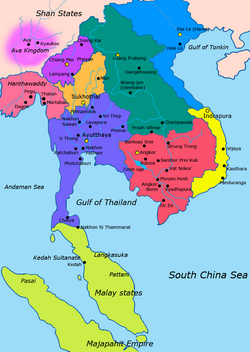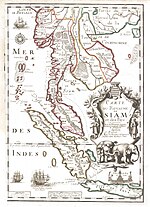
Back مملكة سوكوتاي Arabic Reinu de Sukhothai AST Sukxotay krallığı Azerbaijani سوکوتای کراللیغی AZB Regne de Sukhothai Catalan Sukhothai (Königreich) German Βασίλειο του Σουχοτάι Greek Reino de Sujotai Spanish Sukhothain kuningaskunta Finnish Royaume de Sukhothaï French
Sukhothai Kingdom | |||||||||
|---|---|---|---|---|---|---|---|---|---|
| 1238–1438 | |||||||||
 Sukhothai Kingdom at its greatest extent during the late 13th century under the reign of King Ram Khamhaeng | |||||||||
 Sukhothai Kingdom (orange) in 1400 CE | |||||||||
| Capital |
| ||||||||
| Common languages | Old Thai | ||||||||
| Religion | Theravada Buddhism | ||||||||
| Government | Mandala kingdom | ||||||||
| Monarch | |||||||||
• 1238–1270 (first) | Si Inthrathit | ||||||||
• 1279–1298 | Ram Khamhaeng | ||||||||
• 1347–1368 | Li Thai | ||||||||
• 1419–1438 (last) | Borommapan | ||||||||
| Historical era | Post-classical era | ||||||||
• Founded as city-state | 1127 | ||||||||
• Kingdom established | 1238 | ||||||||
| 1378–1438 | |||||||||
• Annexed to Ayutthaya | 1438 | ||||||||
• Installation of Maha Thammarachathirat | 1569[1] | ||||||||
| Currency | |||||||||
| |||||||||
| Today part of | |||||||||
| History of Thailand |
|---|
 |
|
|
The Sukhothai Kingdom[i] was a post-classical Siamese kingdom (maṇḍala) in Mainland Southeast Asia surrounding the ancient capital city of Sukhothai in present-day north-central Thailand. It evolved from a trading hub to a city-state in 1127[3]: 2–3 and emerged into the kingdom by Si Inthrathit in 1238.[4]: 195–196 Sukhothai existed as an independent polity until 1438 when it fell under the influence of the neighboring Ayutthaya after the death of Borommapan (Maha Thammaracha IV).
Sukhothai was originally a trade center in Lavo—itself under the suzerainty of the Khmer Empire—when Central Thai people led by Pho Khun Bang Klang Hao, a local leader, revolted and gained their independence. Bang Klang Hao took the regnal name of Si Inthrathit and became the first monarch of the Phra Ruang dynasty.
The kingdom was centralized and expanded to its greatest extent during the reign of Ram Khamhaeng the Great (1279–1298), who some historians considered to have introduced Theravada Buddhism and the initial Thai script to the kingdom. Ram Khamhaeng also initiated relations with Yuan China, through which the kingdom developed the techniques to produce and export ceramics like sangkhalok ware.
After the reign of Ram Khamhaeng, the kingdom fell into decline. In 1349, during the reign of Li Thai (Maha Thammaracha I), Sukhothai was invaded by the Ayutthaya Kingdom, a neighboring Thai polity. It remained a tributary state of Ayutthaya until it was annexed by the kingdom in 1438 after the death of Borommapan. Despite this, the Sukhothai nobility continued to influence the Ayutthaya monarchy in centuries after through the Sukhothai dynasty.
Sukhothai is traditionally known as "the first Thai kingdom" in Thai historiography, but current historical consensus agrees that the history of the Thai people began much earlier. The ruins of the kingdom's capital, now 12 km (7.5 mi) outside the modern town of Sukhothai Thani in Sukhothai Province, are preserved as the Sukhothai Historical Park and have been designated a UNESCO World Heritage Site.
- ^ Chris Baker; Pasuk Phongpaichit (2017). A History of Ayutthaya. Cambridge University Press. p. 76.
But 1569 was also the final act of the merger between Ayutthaya and the Northern Cities.
- ^ "เงินตรา" [Currency]. Royal Thai Mint. 2014. Retrieved 29 August 2022.
- ^ Cite error: The named reference
thanitwas invoked but never defined (see the help page). - ^ Cite error: The named reference
Coedeswas invoked but never defined (see the help page).
Cite error: There are <ref group=lower-roman> tags or {{efn-lr}} templates on this page, but the references will not show without a {{reflist|group=lower-roman}} template or {{notelist-lr}} template (see the help page).